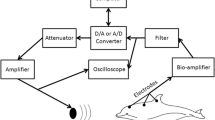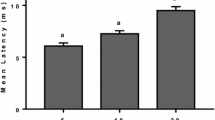Abstract
Steady-state auditory-evoked potentials were recorded noninvasively from alert bottlenosed dolphins, Tursiops truncates, using suction cup electrodes placed on the scalp surface. Responses were elicited using continuous acoustic signals consisting of 2, 3, or 4 tones with lowest frequency at 1000 Hz or 5000 Hz, and having a maximum frequency separation of 171 Hz. Due to the interaction of the stimulus tones, the stimulus waveform was comprised of 1 to 6 dominant temporal envelope components. Evoked responses were averaged in the time domain and Fourier transformed for analysis. The spectrum of the averaged evoked potential contained peaks at Fourier components corresponding to all stimulus envelope frequencies. Thus, scalp potentials, representing the synchronized discharge of large neuronal assemblies, followed the low-frequency temporal envelope of the stimulating waveform whether comprised of 1, 3, or 6 dominant envelope components; this envelope following response (EFR) was the dependent variable in all experiments.
Similar content being viewed by others
References
Aoyagi M, Yoshinori K, Suzuki Y, Fuse T, Koike Y (1993) Optimal modulation frequency for amplitude modulation following response in young children during sleep. Hearing Res 65: 253–261
Au WWL, Moore PWB, Pawloski DA (1988) Detection of complex echoes in noise by an echolocating dolphin. J Acoust Soc Am 83: 662–668
Au WWL, Martin DW (1988) Sonar discrimination of metalic plates by dolphins and humans. In: Nachigall PE, Moore PWB (eds) Animal sonar processes and performance. NATO ASI Series 156: 809–814
Brill RL, Sevenich ML, Sullivan TJ, Sustman JD, Witt RE (1988) Behavioral evidence for hearing through the lower jaw by an echolocating dolphin (Tursiops truncatus). Mar Mamm Sci 4: 223–230
Cody AR, Russell IJ (1987) The responses of hair cells in the basal turn of the guinea pig cochlea to tones. J Physiol (Lond) 383: 551–569
Cohen LT, Rickards FW, Clark GM (1991) A comparison of steadystate evoked potentials to modulated tones in awake and sleeping humans. J Acoust Soc Am 90: 2467–2479
Creuzfeldt O, Helweg FC, Schreiner C (1980) Thalamocortical transformation of responses to complex auditory stimuli. Exp Brain Res 39: 87–104
Dolphin WF, Mountain DC (1991) Scalp potentials follow the low frequency envelope of complex acoustic stimuli. Proc 17th Annual Northeast Bioengineering Conference Hartford, CT pp 215–217
Dolphin WF, Mountain DC (1992) The envelope following response: Scalp potentials elicited in the Mongolian gerbil using sinusoidally AM acoustic signals. Hearing Res 58: 70–78
Dolphin WF, Mountain DC (1993) The envelope following response (EFR) in the Mongolian gerbil to sinusoidally amplitudemodulated signals in the presence of simultaneously gated puretones. J Acoust Soc Am 94: 215–3226
Dolphin WF, Chertoff ME, Burkard RF (1994) Comparison of the envelope following response in the Mongolian gerbil using twotone and sinusoidally amplitude-modulated tones. J Acoust Soc Am 96: 2225–2234
Dolphin WF, Au WWL, Nachtigall PE, Pawloski J (1995) Modulation rate transfer functions to low-frequency carriers in three species of cetaceans. J Comp Physiol A 177: 235–245
Floyd RW (1988) Biosonar signal processing applications. In: Nachigall PE, Moore PWB (eds) Animal sonar processes and performance. NATO ASI Series 156: 773–783
Frisina RD, Smith RL, Chamberlian SC (1990) encoding of amplitude modulation in the gerbil cochlear nucleus: A hierarchy of enhancement. Hearing Res 44: 99–122
Hanna TE, Masakowski YR (1991) Narrowband and broadband envelope cues for aural classification. Naval Submarine Medical Research Laboratory Technical Report 1171
Javel E (1980) Coding of AM tones in the chinchilla auditory nerve. Implications for the pitch of complex tones. J Acoust Soc Am 68: 133–146
Javel E, McGee JA, Horst JW, Farley GR (1988) Temporal mechanisms in auditory temporal coding In: Edelman GM, Gall WE, Cowan WM (eds) Auditory function: neurobiological basis of hearing. Wiley, New York, pp 515–558
Joris PX, Yin TCT (1992) Responses to amplitude-modulated tones in the auditory nerve of the cat. J Acoust Soc Am 91: 215–232
Kim DO, Sirianni JG, Chang SO (1990) Responses of DCN-PVCN neurons and auditory nerve fibers in unanesthetized decerebrate cats to AM and pure-tones: Analysis with autocorrelation/power spectrum. Hearing Res 45: 95–114
Kleinbaum, DG, Kupper LL (1978) Applied regression analysis and other multivariate methods. Duxbury Press, No. Scituate, MA
Kuwada S, Batra R, Maher V (1986). Scalp potentials of normal and hearing impaired subjects in response to sinusoidally amplitudemodulated tones. Hearing Res 21: 179–192
Levi EC, Folsom RC, Dobie RA (1993) Amplitude modulation following response (AMFR): Effects of modulation rate, carrier frequency, age, and state. Hearing Res 68: 42–52
Møller AR (1972) Coding of amplitude and frequency modulated sounds in the cochlear nucleus of the cat. Acta Physiol Scand 86: 223–228
Møller AR (1976) Dynamic properties of primary auditory nerve fibers compared with cells in the cochlear nucleus. Acta Physiol Scand 86: 223–228
Møller AR, Rees A (1986) Dynamic properties of responses of single neurons in the inferior colliculus of the rat. Hearing Res 24: 203–215
Palmer AR, Winter IM (1992) Cochlear nerve and cochlear nucleus responses to the fundamental frequency of voiced speech sounds and harmonic complex tones. In: Cazals Y, Demeny L, Horner K (eds) Advances in the biosciences (vol 83): auditory physiology and perception. Pergamon Press, pp 231–239
Patterson RD, Nimmo-Smith I, Holdsworth J, Rice P (1988). Spiral vos final report, Part A: The auditory filterbank. Cambridge Electronic Design, Contract Rep. (Apu 2341)
Picton TW, Skinner CR, Champagne SC, Kellet AJC, Maiste AC, (1987) Potentials evoked by the sinusoidal modulation of the amplitude or frequency of a tone. J Acoust Soc Am 82: 165–178
Popov VV, Supin AY (1990a) Auditory brainstem responses in characterization of dolphin hearing J Comp Physiol A 166: 385–393
Popov VV, Supin AY (1990b) Location of an acoustic window in dolphins. Experientia 46: 53–56
Rees A, Møller AR (1987) Stimulus properties influencing the responses of inferior colliculus neurons to amplitude-modulated sounds. Hearing Res 27: 129–143
Rees A, Palmer AR (1989) Neuronal responses to amplitude modulated and pure-tone stimuli in the guinea pig inferior colliculus and their modification by broadband noise. J Acoust Soc Am 85: 1978–1994
Robles L, Ruggero ML, Rich NC (1990) Two-tone distortion products in the basilar membrane of the chinchilla cochlea. In: Dallos P, Geisler CF, Matthews JW, Ruggero MA Steele CR (eds) Mechanics and biophysics of hearing. Springer, New York, pp 304–311
Ridgway SH, Bullock TN, Carder DA, Seeley RL, Woods D, Galambos R (1981) Auditory brainstem response in dolphin. Proc Natl Acad Sci USA 78: 1943–1947
Schreiner CE, Urbas JN (1988) Representation of amplitude modulation in the auditory cortex of the cat. II. Comparison between cortical fields. Hearing Res 32: 49–64
Schwartz M (1990) Information transmission, modulation, and noise. McGraw Hill, New York
Author information
Authors and Affiliations
Rights and permissions
About this article
Cite this article
Dolphin, W.F. Auditory evoked responses to amplitude modulated stimuli consisting of multiple envelope components. J Comp Physiol A 179, 113–121 (1996). https://doi.org/10.1007/BF00193439
Accepted:
Issue Date:
DOI: https://doi.org/10.1007/BF00193439




